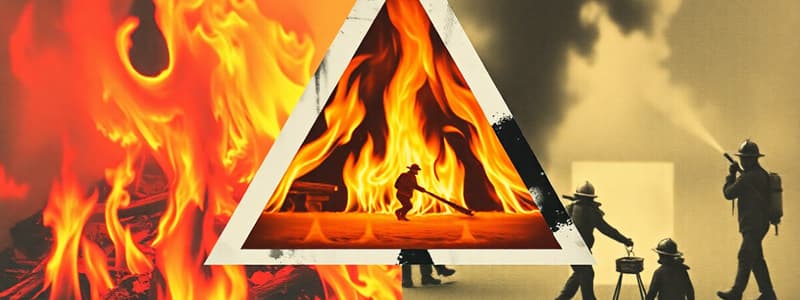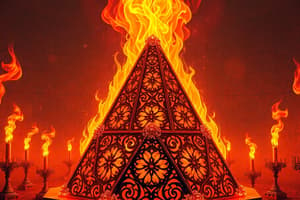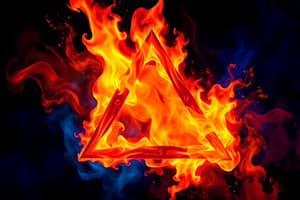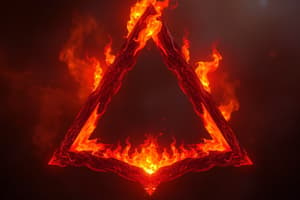Podcast
Questions and Answers
A small fire involving gasoline has ignited in a storage area. Which type of fire extinguisher is MOST suitable for suppressing this fire?
A small fire involving gasoline has ignited in a storage area. Which type of fire extinguisher is MOST suitable for suppressing this fire?
- Class D
- Class B (correct)
- Class A
- Class C
In a commercial kitchen, a fire starts in a deep fryer containing cooking oil. Which class of fire extinguisher is specifically designed to handle this type of fire?
In a commercial kitchen, a fire starts in a deep fryer containing cooking oil. Which class of fire extinguisher is specifically designed to handle this type of fire?
- Class C
- Class A
- Class K (correct)
- Class B
During a fire, heat is transferred through a metal pipe from one room to another. This is an example of which type of heat transfer?
During a fire, heat is transferred through a metal pipe from one room to another. This is an example of which type of heat transfer?
- Convection
- Advection
- Radiation
- Conduction (correct)
A fire is rapidly growing in a room, and all the contents are starting to ignite simultaneously. This phenomenon is known as:
A fire is rapidly growing in a room, and all the contents are starting to ignite simultaneously. This phenomenon is known as:
Which of the following is the MOST appropriate first action to take upon discovering a fire in your workplace?
Which of the following is the MOST appropriate first action to take upon discovering a fire in your workplace?
Why is it important to close doors and windows during a fire?
Why is it important to close doors and windows during a fire?
Which type of fire detection system is MOST suitable for areas where rapid temperature increases are expected?
Which type of fire detection system is MOST suitable for areas where rapid temperature increases are expected?
What is the primary purpose of a fire alarm control panel (FACP)?
What is the primary purpose of a fire alarm control panel (FACP)?
What is the correct order of steps to use a fire extinguisher, according to the PASS acronym?
What is the correct order of steps to use a fire extinguisher, according to the PASS acronym?
In wildland firefighting, what does 'indirect attack' primarily involve?
In wildland firefighting, what does 'indirect attack' primarily involve?
Flashcards
Fire Triangle
Fire Triangle
Heat, fuel, and oxygen are the three elements.
Class A Fires
Class A Fires
Ordinary combustibles like wood and paper.
Class B Fires
Class B Fires
Gasoline, oil, and grease are examples.
Class C Fires
Class C Fires
Signup and view all the flashcards
Class D Fires
Class D Fires
Signup and view all the flashcards
Class K Fires
Class K Fires
Signup and view all the flashcards
Conduction
Conduction
Signup and view all the flashcards
Convection
Convection
Signup and view all the flashcards
Ionization Smoke Detector
Ionization Smoke Detector
Signup and view all the flashcards
Flashover
Flashover
Signup and view all the flashcards
Study Notes
- Fire emergencies are incidents involving uncontrolled fires that pose a threat to life, property, and the environment.
- Effective response requires understanding fire behavior, implementing prevention measures, and executing coordinated emergency procedures.
Fire Dynamics
- The fire triangle illustrates the three elements needed for a fire to start and sustain itself: heat, fuel, and oxygen.
- Removing any of these elements will extinguish the fire.
- The fire tetrahedron expands on the fire triangle by adding a fourth element: a chemical chain reaction, which sustains the fire.
- Understanding the fire tetrahedron is crucial for selecting the appropriate extinguishing agent.
- Different classes of fires require different extinguishing agents:
- Class A: Ordinary combustibles (wood, paper, cloth).
- Class B: Flammable liquids (gasoline, oil, grease).
- Class C: Electrical fires.
- Class D: Combustible metals (magnesium, titanium, sodium).
- Class K: Kitchen fires (cooking oils and fats).
- Fire spreads through conduction, convection, and radiation.
- Conduction: Heat transfer through direct contact.
- Convection: Heat transfer through the movement of fluids (liquids or gases).
- Radiation: Heat transfer through electromagnetic waves.
- Flashover is a rapid transition to a state of total surface involvement in a fire, where all exposed materials ignite simultaneously.
- Backdraft is an explosive event that occurs when oxygen is suddenly introduced into a smoldering, oxygen-depleted environment.
Fire Prevention
- Implement fire safety regulations and codes in buildings and workplaces.
- Regularly inspect and maintain fire protection systems (fire alarms, sprinkler systems, fire extinguishers).
- Store flammable materials properly in approved containers and locations.
- Control ignition sources such as smoking, open flames, and electrical equipment.
- Educate occupants and employees about fire safety procedures and evacuation plans.
- Conduct regular fire drills to practice evacuation procedures.
- Install and maintain smoke detectors in homes and workplaces.
- Ensure clear and unobstructed evacuation routes.
Fire Detection and Alarm Systems
- Smoke detectors sense the presence of smoke particles in the air.
- Ionization smoke detectors use radioactive material to detect small particles.
- Photoelectric smoke detectors use a light beam and sensor to detect larger particles.
- Heat detectors activate when the temperature reaches a predetermined level.
- Fixed-temperature heat detectors activate at a specific temperature.
- Rate-of-rise heat detectors activate when the temperature increases rapidly.
- Flame detectors sense the presence of flames by detecting infrared or ultraviolet radiation.
- Fire alarm systems alert occupants of a fire and initiate evacuation procedures.
- Manual pull stations allow occupants to manually activate the alarm.
- Automatic fire alarm systems are triggered by smoke detectors, heat detectors, or flame detectors.
- Fire alarm control panels (FACPs) monitor and control the fire alarm system.
- Notification appliances include audible alarms (horns, bells) and visual alarms (strobes).
- Fire suppression systems automatically extinguish or control fires.
- Sprinkler systems discharge water to suppress fires.
- Wet pipe sprinkler systems contain water in the pipes at all times.
- Dry pipe sprinkler systems contain pressurized air or nitrogen in the pipes.
- Pre-action sprinkler systems require two events to occur before water is released.
- Deluge sprinkler systems release a large amount of water simultaneously.
- Clean agent systems use gaseous agents to suppress fires without damaging equipment.
- Carbon dioxide (CO2) systems displace oxygen to extinguish fires.
- Foam systems use foam to suppress fires involving flammable liquids.
- Sprinkler systems discharge water to suppress fires.
Emergency Response Procedures
- Activate the fire alarm system to alert occupants and the fire department.
- Evacuate the building or affected area immediately.
- Follow established evacuation routes and procedures.
- Assist individuals with disabilities or special needs.
- Close doors and windows to contain the fire.
- Report the fire to the fire department with accurate information about the location, size, and type of fire.
- Meet first responders and provide them with information about the fire and any occupants who may be trapped.
- Do not re-enter the building until authorized by the fire department.
- If trapped, stay low to the ground to avoid smoke and heat.
- Signal for help by waving a light-colored cloth or flashlight at a window.
Fire Extinguishers
- Fire extinguishers are portable devices used to extinguish small fires.
- Class A extinguishers are used for ordinary combustibles.
- Class B extinguishers are used for flammable liquids.
- Class C extinguishers are used for electrical fires.
- Class D extinguishers are used for combustible metals.
- Class K extinguishers are used for kitchen fires.
- Fire extinguishers are rated based on the size and type of fire they can extinguish.
- The PASS acronym describes the steps for using a fire extinguisher:
- Pull the pin.
- Aim the nozzle at the base of the fire.
- Squeeze the handle.
- Sweep from side to side.
- Fire extinguishers should be inspected monthly to ensure they are in good working condition.
- Fire extinguishers should be recharged or replaced after each use.
Personal Protective Equipment (PPE)
- Firefighters and emergency responders wear PPE to protect themselves from the hazards of fire.
- Structural firefighting gear includes a helmet, coat, pants, gloves, boots, and a self-contained breathing apparatus (SCBA).
- Wildland firefighting gear includes a fire-resistant shirt and pants, gloves, boots, and a fire shelter.
- Proximity suits are used for fighting fires that involve high levels of radiant heat.
- SCBA provides a supply of breathable air in hazardous atmospheres.
- Respiratory protection is essential to protect against smoke, toxic gases, and oxygen deficiency.
Wildland Fires
- Wildland fires are uncontrolled fires that occur in forests, grasslands, and other natural environments.
- Factors that contribute to wildland fires include dry vegetation, high temperatures, wind, and lightning.
- The wildland-urban interface (WUI) is the area where wildland vegetation meets urban development.
- Wildland fires can spread rapidly and threaten homes, infrastructure, and natural resources.
- Fire behavior is influenced by fuel, weather, and topography.
- Fire suppression tactics include direct attack, indirect attack, and defensive actions.
- Direct attack involves extinguishing the fire at its edge.
- Indirect attack involves creating firebreaks to contain the fire.
- Defensive actions involve protecting structures and evacuating people from the path of the fire.
High-Rise Fires
- High-rise fires present unique challenges due to the height of the building, limited access, and potential for rapid fire spread.
- Firefighters use standpipe systems to supply water to upper floors.
- Smoke and heat can rise quickly through stairwells and elevator shafts.
- Occupant evacuation can be difficult and time-consuming.
- Fire command centers are established to coordinate firefighting operations.
- Positive pressure ventilation (PPV) can be used to remove smoke from the building.
- High-rise buildings should have fire-resistant construction and compartmentalization to limit fire spread.
Post-Fire Procedures
- Ensure the fire is completely extinguished and there is no risk of rekindling.
- Conduct a thorough investigation to determine the cause of the fire.
- Document the extent of the damage and loss.
- Secure the property to prevent unauthorized access.
- Coordinate with insurance companies and other stakeholders.
- Provide support and resources to victims of the fire.
- Evaluate the effectiveness of the fire response and identify areas for improvement.
- Restore fire protection systems and equipment.
- Dispose of fire debris and hazardous materials properly.
Training and Education
- Fire safety training is essential for employees, occupants, and emergency responders.
- Training should cover fire prevention, evacuation procedures, and the use of fire extinguishers.
- Fire drills should be conducted regularly to practice evacuation procedures.
- Firefighter training includes firefighting techniques, rescue procedures, and hazardous materials response.
- Continuing education is important to stay up-to-date on the latest fire safety practices and technologies.
- Public education programs can raise awareness about fire safety and prevention.
Studying That Suits You
Use AI to generate personalized quizzes and flashcards to suit your learning preferences.




